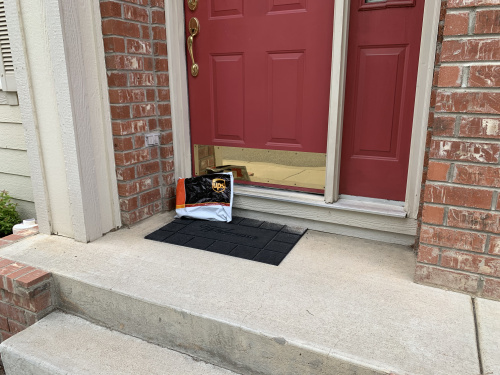Today I'd love to talk about the problem at hand and how smaller outfits and makers can navigate it. Obviously the important part of all of this is staying safe and healthy, which is why I have no qualms about the issue we're facing. However, it's definitely created more work for us here at SparkFun, and has affected projects I'm working on outside of SparkFun as well.
Unless you're a larger company, you're likely in a position where getting the parts for your product or project has become more difficult. How difficult it is really depends on the parts and amounts, and the "why" depends on several different aspects. Let's talk about some that might come up.
Chain Reaction
You're not alone - manufacturing closed down across the board, so in some cases, your supplier's suppliers are running into issues. We actually had this happen with a power supply we buy that couldn't be built due to a part that was out of stock with long lead times. For something like a power supply, that's upwards of 10 components that each represent a potentially lengthy lead time. Sometimes it's not an issue, but when the part is unique or the product is a priority, then you need to get creative.
New product evaluation packages have been shipping directly to my house as I've been working from home. I'm sure the number of international packages have the delivery folk wondering...
Shipping
Shipping is also a big issue. Backlogged orders, preferential shipping for more important shipments (medical supplies), and decreased shipping ability in general is making things difficult, especially at the international level. This has the potential to put you in a more difficult situation: do you wait on the parts, hoping they get to you in a timely manner, or do you risk buying from another source and hope it gets there quicker than the original order (at this point potentially buying double what you need)? The uncertainty behind shipping can be a huge headache.
Shift in Demand
I bet you didn't think back in January it would be this difficult to get a webcam. The pandemic has created large swings in demand and where it's focused. Manufacturers are scrambling to keep up with demand on devices like IR thermometers, which may not have been properly planned for. Apart from the reasons above, there are always going to be lead times, so companies can't simply crank production to 11. Even if you're not directly working on a similar product (or even using a similar sensor), it could still have an effect on your ability to get the parts you need.
Being a Small Fish in a Big Pond
When you're talking about electronics in general, it's easy to fall into this category. The bigger consumer electronics manufacturers are making sure the two months of manufacturing that was lost isn't going to affect their ability to deliver the numbers they need to hit their goals (think Apple being short on the next iPhone at launch). These companies will leverage their volume business to make sure their orders get priority in shipping and manufacturing. I'm even hearing of some companies buying out manufacturing capabilities for the next two years. This means your product becomes second class when it comes to what makes into the cargo ship or onto the production line.
Is this Permanent?
No, in fact most of these things often happen separately. Work strikes at ports, sudden shifts in demand, manufacturing closures, and other similar occurrences all happen here and there with similar effects. What makes this different is all the effects happening at once, so your once clean-cut purchasing and sourcing track now resembles more of a maze.
The important thing to remember is that this is temporary. Take the lessons from it, but the supply chain will one day return to normal. I think the most we'll see is a move away from just-in-time manufacturing in the short term.
How to Navigate This
Many of us at SparkFun are navigating something of this magnitude for the first time, like most of you. Hopefully it has had very little effect on you, as I would assume has been the case for most (remember, we're talking electronics here, not toilet paper). But with the volume of parts that move through SparkFun, we've found a few ways give you a better chance of getting what you need on time. It comes down to either using the lower-risk suppliers or looking to the less popular ones.
When I say lower risk, I'm referring to the risk mentioned in the first part of the article. Your best option is going to be parts that are already built (in-stock), require minimal logistics (domestic shipping), and can be ordered immediately. If you're thinking of the cheap-fast-good explanation, these will be the "fast." For us in the United States, it's going to be companies such as Mouser, Digikey or Newark.
These are all sites that ship from domestic locations with stock on hand, and your stock is reserved the second you place an order. While the last part may not seem important, it is in relation to the small fish/big pond stuff we talked about earlier. It's easy for us small guys to get put on the back burner to appease the bigger companies. This won't happen with a system like the ones on those sites. If you're a bigger buyer/company, manufacturer reps might be a go-to as well, but the key question to ask is whether there is stock on hand.
Sometimes the amount you need isn't readily available from these sites or companies - that's when you need to start looking to the smaller, less popular retailers. Everyone is going to search the names they know first, so dig a few Google search pages back.
Take the webcams mentioned above, for example: the first places sold out were probably Amazon, Newegg, B&H Photo and the big box stores. Think about the more targeted uses for a webcam - you'll find specality online stores for things like VOIP or Home Security. If there's stock to be had, these will likely be the places to find it.
Getting into electronics components becomes a little harder for these sites, but Octopart is your friend, and you might end up finding another great fall-back supplier (secondary suppliers should be a big lesson for everyone through this).








Distributors like Digi-Key are also the Good part. If you buy parts from them they're going to be genuine components from major manufacturers. What they are not is Cheap. (The saying is cheap-fast-good, pick two. A supplier that actually offers at least two is worth keeping.) And don't forget Arrow; they offer free shipping on orders over $50, which is a useful benefit.
Fortunately Arrow changed their tune a few years ago. I recall being politely told by an Arrow rep that they weren't interested in "hobbyist" business, but here's the URL for Digi-Key. They've "seen the light" in that tomorrow's "killer app" is today's "hobbyist project"... The downturn of 2008 made "believers [in hobbyists]" of several of the printed circuit board companies -- notably the ones who survived the recession by accepting business from hobbyists. (FWIW, I first did business with Digi-Key back in about 1973 -- I'm impressed that they've never forgotten the hobbyists, despite the fact that a large portion of their business comes from big factories these days.)
Yes, total sea change. The maker movement really turned things around. Distributors saw that there was a significant amount of money to be made there. And now that everybody except really large buyers pay with credit cards, it's not as much of a hassle for the distributors.
There was a time when most distributors would ONLY sell to customers with an established account; you usually get net-15 or net-30 terms on those, so the company had to do credit checks and individuals couldn't open them at all. There were only a few that welcomed individual buyers; Digi-Key and Mouser specialized in it, and Lafayette would also accept check payments (and cash at the main store in Syosset NY) back when they were still a component distributor.
Another sea change was the proliferation of inexpensive development boards. Arduino was a catalyst, but then we started to see things from semiconductor manufacturers like STM's Discovery and Nucleo boards (the latter even copied the Arduino footprint so you could put shields on them!) and the PSoC prototyping kits. Along with cheaper boards, the companies started to release free-to-use development software, either cut-down versions of their commercial packages or fully open source and unlimited IDEs. That was a response to the fact that many professional engineers are also makers; they would work with cheap development boards at home and then design those microcontrollers into their professional work.
I first started in the semiconductor industry in 1980. That was something of an interesting time to be working for a chip manufacturer. At that time, if you were a "single source" for a part, you'd sell very few parts -- at the time, nearly all of the chip makers were relatively small companies (some would make SparkFun look huge), and a lot of them went bust. The way around this, for both sides, was "second sourcing", so virtually all of the manufacturers would enter into second source agreements with other companies (who were ostensibly competitors). The downside was that during periods when the market was "hot" for parts, customers would place orders for (at least compatible) parts with every chip maker who made them, and then when the customer actually got the order from one of them they'd cancel all of the other orders. This made a HUGE problem for the chip makers, as it would take several weeks from "start the lot" to "ship them".
The other comment is that the "bean counters" always worry about "cost of inventory", and usually totally ignore the "cost of LACK of inventory"...
That is a really good point, the cost of lack of inventory always needs to be accounted for.